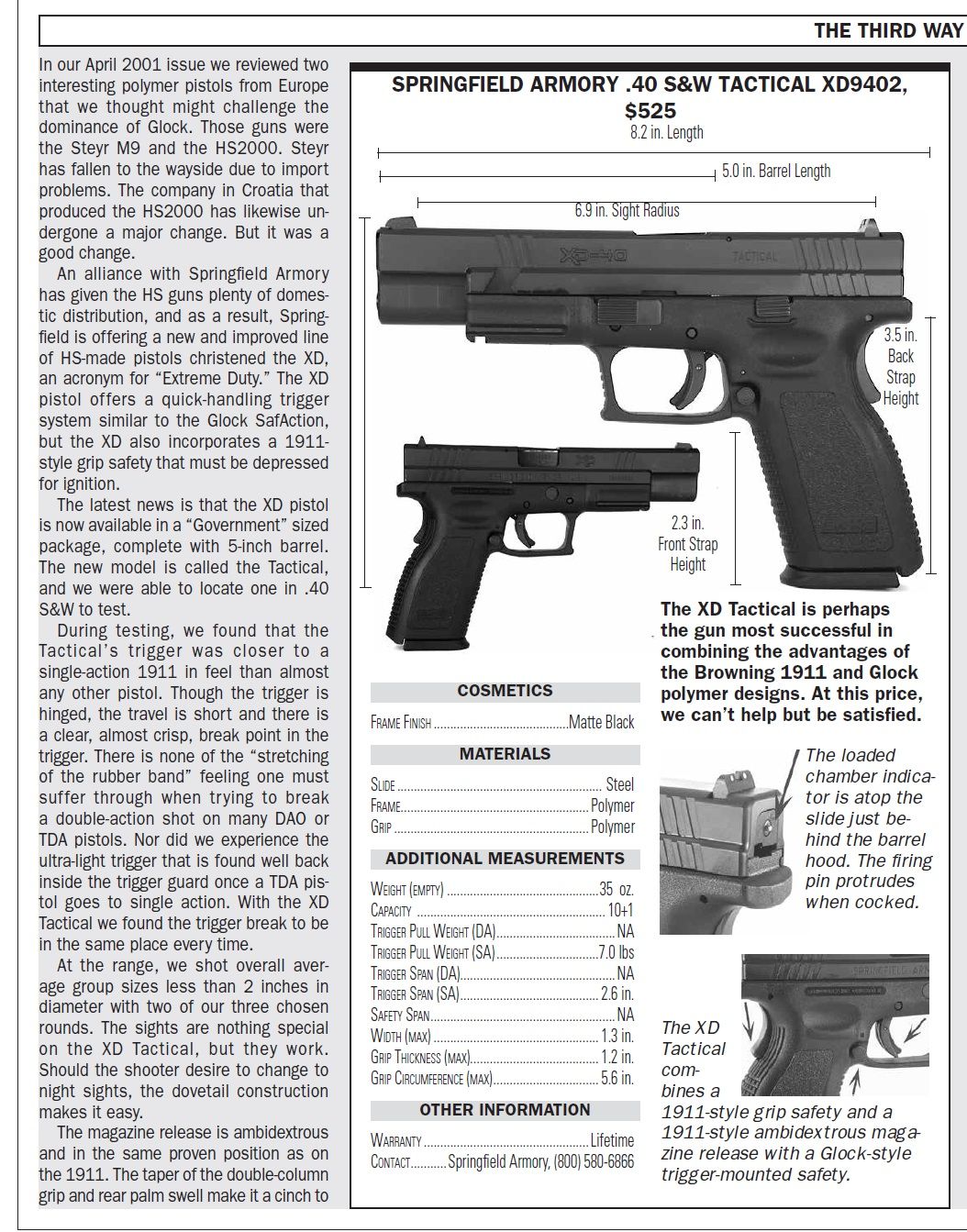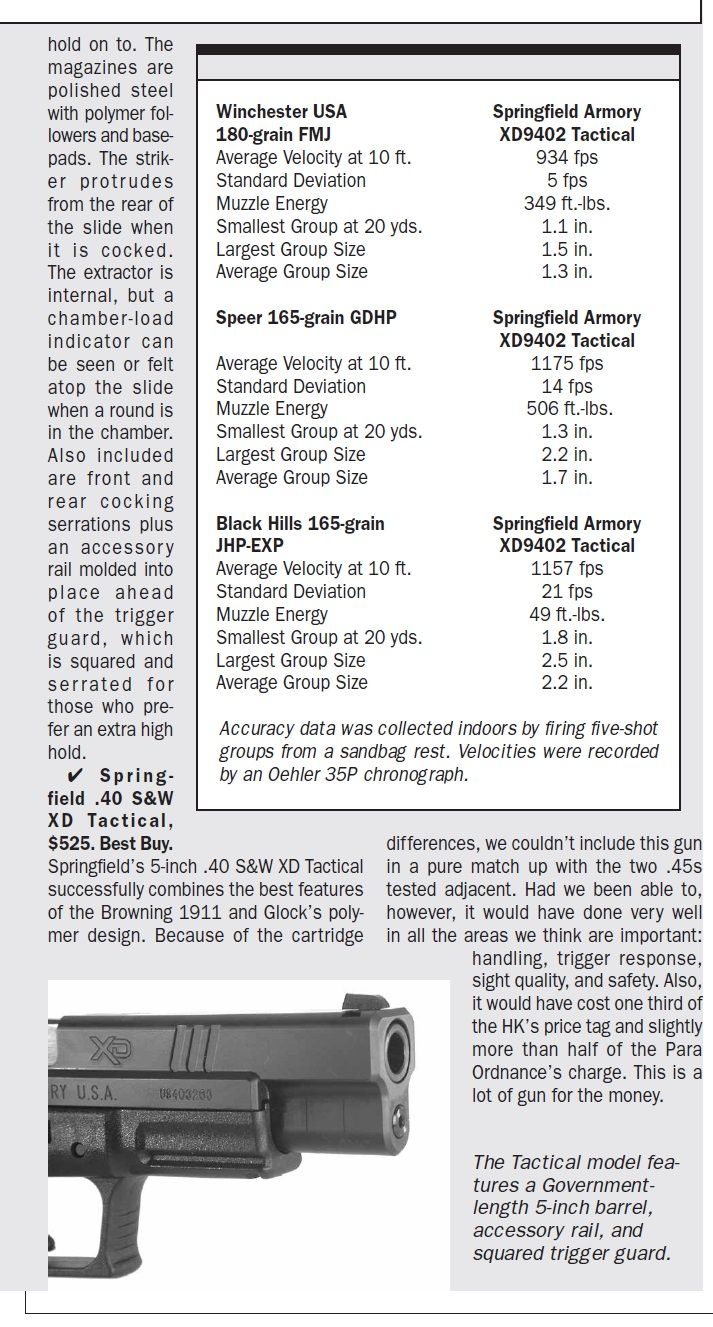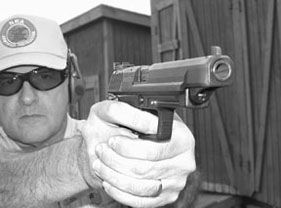One could make a solid argument that the most important trends and successful designs of the 20th century began with John Browning and were redirected much later by Gaston Glock. Browning, of course, built the first 1911-style single-action handgun design. Glock, for his part, helped popularize polymer pistols as reliable, affordable alternatives to steel and aluminum frames, and married reduced manufacturing costs, simplicity of operation, and ease of maintenance into packages consumers would accept, and in many cases, prefer.
We recently tested two guns that combine interesting developments in the .45 ACP self-defense genre: HK’s USP Elite, $1,533, a polymer .45 that offers both single-action and double-action firing modes; and the LDA 7.45 (single-stack) from Para Ordnance, an $899 steel-framed product that looks like a 1911 on the outside, but which varies from Browning’s design in the crucial area of trigger operation. Here’s what we thought of both guns.
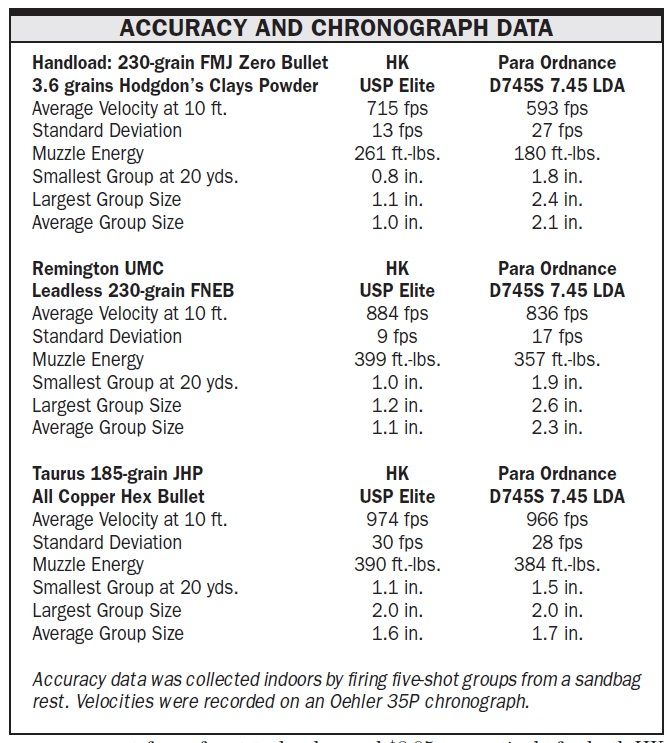
Para Ordnance 7.45 LDA D745S .45 ACP, $899
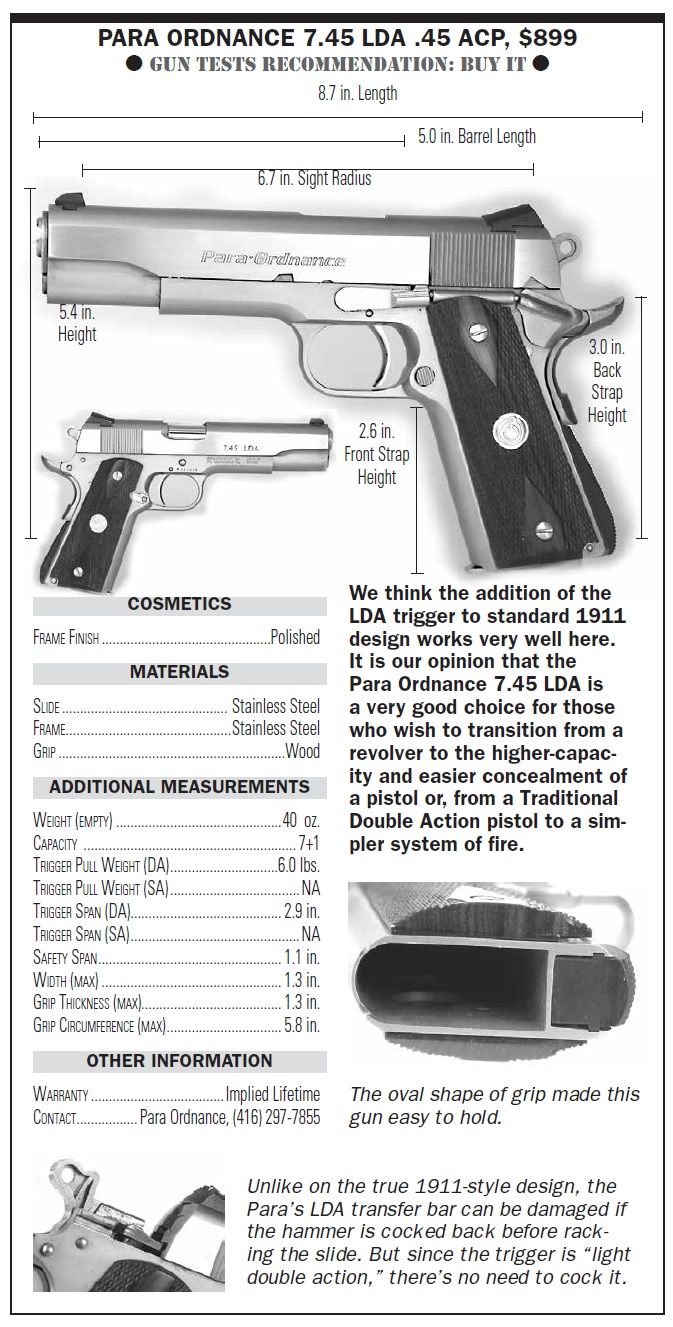
Browning’s 1911 single-action trigger design presents several advantages over other systems. Once loaded, it offers single-handed operation with two mechanical safeties. The grip safety must be compressed and the thumb safety must be lowered to fire the gun. In our view, this is a very safe system that happens to produce a great trigger pull if firing a shot becomes necessary.
However, other observers believe the SA cocked-and-locked mechanism itself is unsafe (or at least legally questionable in a lawsuit), and this misguided view has spurred the development of double-action triggers in guns that on the outside look like 1911s. The Para Ordnance 7.45 LDA is one such product.
In our December 2002 issue we made the assumption that “LDA” in Para Ordnance parlance stood for “light double-action” trigger. The LDA system pre-loads the firing mechanism so that two mechanical actions, raising and releasing the hammer, can be achieved without the full weight of this process being transferred to the trigger pull.
So it would seem that the LDA pistols from Para Ordnance offer the best of both worlds. Grip safety, thumb safety, and a long enough trigger to get the owner out of some hot water liability-wise. But does the LDA trigger system perform?
According to the results of our December test of the subcompact C 6.45 LDA, this system is fast. Additional proof is found in the results of the inaugural United States Practical Shooting Association (USPSA) Factory Gun Nationals. Wide-body 9mm and .40 S&W Para Ordnance pistols fitted with LDA triggers were victorious, so the potential is certainly there. We wanted to know how the LDA trigger worked in a bigger gun.
The Para Ordnance 7.45 LDA D745S is a 5-inch single-stack “Government” model chambered for .45 ACP. Para Ordnance made its fame adapting the staggered loading magazine that increased the capacity of the 1911 design, but like other companies have backtracked to add a traditional single-stack pistol to the company’s lineup. The reason for this goes beyond nostalgia. The single stack pistol is flat, and no matter how long the barrel is, this classic design conceals very well. Plus it is friendly to the hand, with a natural pointing quality. Also, the available aftermarket parts to personalize is nearly endless.
The single-stack 7.45 LDA is an all-steel pistol fashioned from two different grades of stainless steel to prevent galling. The LDA was the heavier gun in the test, and its all-steel construction meant that its weight was more evenly distributed than a polymer gun that is plastic down low and steel up top. As a result of its weight (and to a degree the way it fit in our hands), the 7.45 LDA presented the least amount of felt recoil. Not only did this make it easier to shoot, but was less tiring.
The grip area on this pistol consisted of checkered wood panels, a smooth front strap and a checkered mainspring housing with mild arch to fill the palm. We never felt we had to adjust our grip between shots, and the LDA trigger only required a smooth sweep and follow-through. Also, we never felt that we had to meet and overcome a hard break point each time we fired. Otherwise the LDA operates like a 1911, with one exception. When pulling back the slide, the shooter should not thumb back the hammer. Doing so can damage the transfer bar that connects the hinged trigger to the firing pin assembly.
Our accuracy tests were performed indoors due to inclement weather. We found that the sights didn’t work so well in reduced indoor light. This was in contrast to our test of the compact model, where shooting took place outdoors in optimum light. In this case we just couldn’t get enough light on and around the front sight. We found that the other pistols were better suited (sighted?) for the available light. The sights are well serrated, and as a result they don’t reflect light. The rear sight contains two white dots; there’s one white dot in the front blade. However, we found the application of the paint to be sloppy. We like the spire shaped no-snag rear assembly, but overall we thought a good solution would be to simply inlay a set of tritium dots where the paint was fading.
We think this gun gets high marks for shooting the softest and being shooter friendly. It did not produce spectacular groups, but on average was very acceptable, nearly tying the much more expensive HK USP Elite firing the solid copper 185-grain bullets from Taurus. With top-grade sights, our results would likely be much better.
Heckler & Koch USP Elite .45 ACP, $1,533
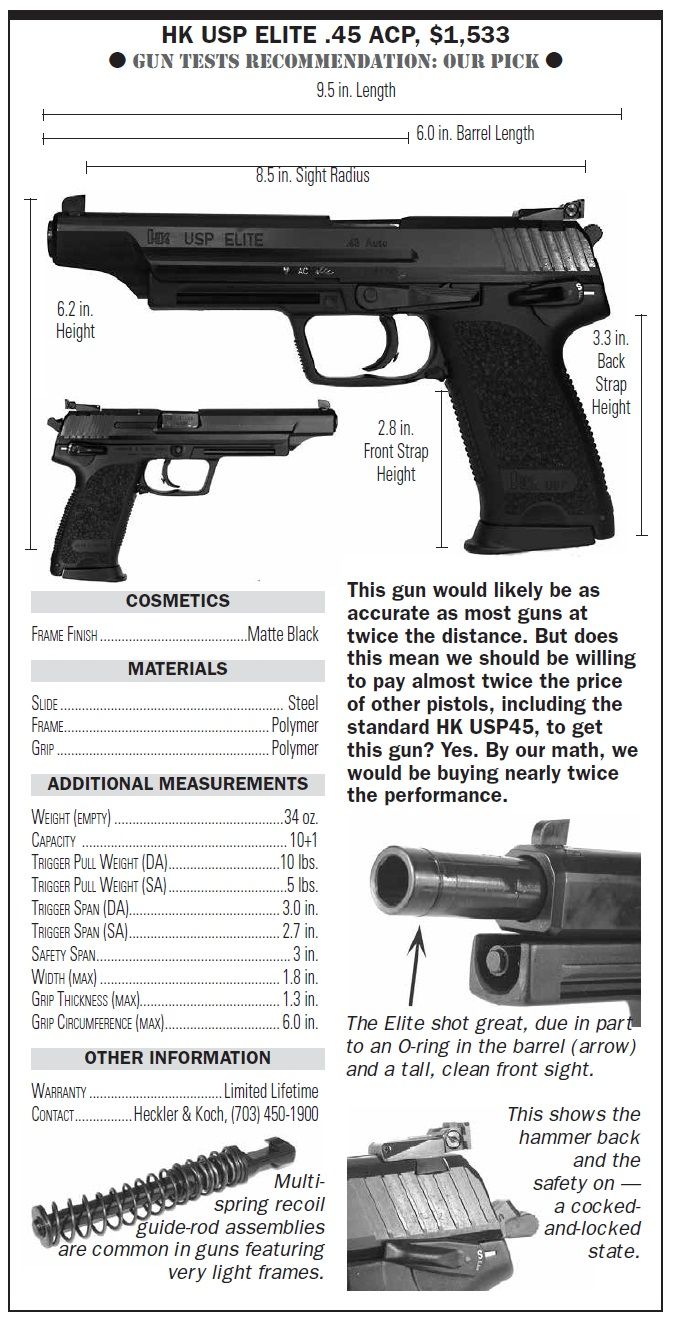
We mentioned above that the Para Ordnance pistol did not produce spectacular results, but in a sense this is unfair — the HK USP Elite set a very high comparative standard. Our first three shots (firing a special handload) produced a single hole, and after five shots the group size expanded to just under .80 inches in diameter. The load was developed for accuracy and fashioned from fresh Remington (R-P, headstamp) cases, Hodgdon’s Clays powder, Federal’s number 150 primer, and a 230-grain FMJ bullet by Zero from Roze Distribution, (800 204-1526). Our accuracy shots were fired single action only. This brings us to the Elite’s most distinctive characteristic. The gun can be fired with the first shot double action and subsequent shots single action (Traditional Double Action or, TDA), or the shooter has the option of cocked-and-locked carry (hammer back, thumb safety on). The thumb safety locks the hammer back when rotated upward, but will also decock the hammer when swept downward. Certainly, the owner of a USP pistol should train for both modes of fire. For those used to holding a 1911 with thumb above or riding the safety, we did not experience accidental decocking during either live or dryfire exercises (and we tried diligently to create this unwanted result). Rumors that tell of accidental decocking may be true, but we suspect that if they are, it was because the pistol had been improperly modified. We have found some disturbing side effects to poorly executed trigger jobs on TDA guns.
Given the results of our accuracy tests, the measured weight of the Elite’s glassy trigger pull for DA and SA of 10 and 5 pounds respectively should suffice. Another distinctive feature of the HK USP series is the ambidextrous shovel-style magazine release at the rear of the trigger guard. You can release the mag with your trigger finger, your middle finger or if your strong-hand thumb is long enough, you can use it to push downward and release the magazine. Find the way that works best for you.
Why is the Elite model so much more expensive than the standard USP model? We found no apparent mechanical difference in the trigger, but overall we saw more refined performance, a sign that more time was put into fitting and assembly.
The sights were some of the best we’ve encountered, but the fully adjustable rear sight is not tucked entirely out of harm’s way, in our view. Also, the tall front sight will likely demand a sight channel built into the proper holster.
Could this gun be used for duty? Yes, but we do not think the expensive USP Elite will show up on the general issue list any time soon because of its cost. But this pistol may be key to another agenda.
In the Practical Shooting sports, especially USPSA/IPSC, the HK USP pistols are represented by a small corps of shooters because the guns offer fast handling, accuracy, and capacity without special setup work. After shooting the $1,533 Elite, we think you could buy this gun off the shelf and be competitive without having to wait for or pay for a custom gun. Additionally, the split personalities of the USP pistols (TDA or SA operation) make it eligible for competition in IPSC Standard or USPSA Limited 10 divisions and the Production Division that specifies TDA fire only.
One of the reasons why the Elite model excels is due to the addition of an “O-ring” to the front portion of the barrel where it meets with the front of the slide. This acts like a bushing that floats on the barrel rather than being attached to the slide. Another reason is the crystal clear sights in tune with a long sight radius of 8.5 inches.
On the downside, we found significant differences in muzzle flip between the USP Elite and the Para Ordnance 7.45 LDA pistols. In our opinion the key difference between these two guns is the grip. Ergonomically, the Para Ordnance is a standard single-stack 1911 with removable grip panels that can be changed to create the proper swell and circumference to fit the individual. Supplied panels on our 7.45 LDA resulted in a grip circumference of 5.8 inches. This includes a maximum width of 1.3 inches and a maximum measurement from front to back strap of nearly 2.3 inches tapering to less than 2 inches below the trigger guard. The oval circumference of the single-stack Para Ordnance filled our hands with less effort than the HK pistol, allowing us to surround the gun evenly and hold on with less conscious effort. The grip area of the USP Elite actually measures 0.1 inch thinner and 0.1 inch less from front to back. However, we still experienced less control because the grip does not taper from bottom to top, and the flat side panels were slippery.
One popular modification is to cover the molded pebble finish with skateboard grip tape. You don’t have to worry about your art and crafts skills because pre-cut forms by DecalGrip are available from Natchez Shooting Supply, (800-251-7839). These peel-and-stick panels of sand or rubber finish cost as little as $7.95 and $8.95 respectively for both HK and Glock pistols. Still, the Elite proved very easy to index from any start position. Accuracy was impressive. At 20 yards we printed only one group that measured more than 1.9 inches from center to center. Taking into account that our smallest groups from each selection of test ammunition ranged from 0.8 to 1.1 inches, we hate ourselves for shooting that one big group.
Gun Tests Recommends
Para Ordnance 7.45 LDA Model D745S, $899. Buy It. Single stacks always have the most natural feel, and the 7.45 LDA is no exception. The trigger is easy to learn.
HK USP Elite $1,533. Our Pick. The Elite version of HK’s USP series is just that. It has outstanding accuracy, select fire (SA or TDA) and a bold look.
Also With This Article
